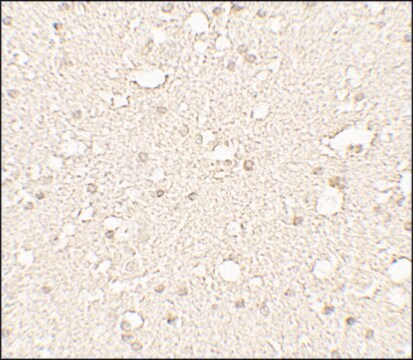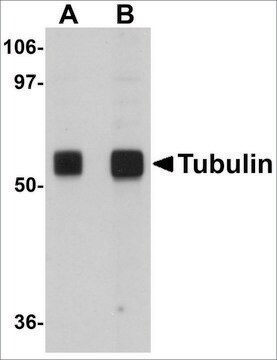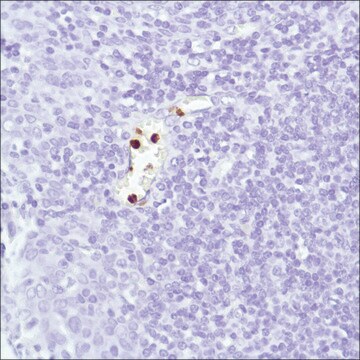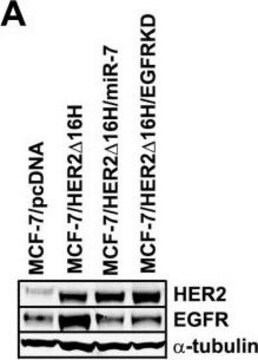CBL270-I
Anti-alpha-Tubulin Antibody, clone YOL1/34
clone YOL1/34, from rat
Synonim(y):
Tubulin alpha-1 chain, alpha-tubulin
About This Item
Polecane produkty
pochodzenie biologiczne
rat
Poziom jakości
forma przeciwciała
purified immunoglobulin
rodzaj przeciwciała
primary antibodies
klon
YOL1/34, monoclonal
reaktywność gatunkowa
rat, mouse, human, yeast, amoeba, porcine
metody
ELISA: suitable
affinity binding assay: suitable
electron microscopy: suitable
immunocytochemistry: suitable
western blot: suitable
izotyp
IgG2aκ
numer dostępu NCBI
numer dostępu UniProt
Warunki transportu
ambient
docelowa modyfikacja potranslacyjna
unmodified
informacje o genach
Saccharomyces cerevisiae ... Tub1(854889)
human ... TUBA1A(7846)
Opis ogólny
Specyficzność
Immunogen
Zastosowanie
Western Blotting Analysis: 1 µg/mL from a representative lot detected alpha-tubulin in 10 µg of NIH/3T3 mouse fibroblast and PC12 rat pheochromocytoma cell lysates.
Affinity Binding Assay: Pig brain α-tubulin, α-tubulin/β-tubulin heterodimer, as well as α-tubulin proteolytic fragments a.a. 414-425 and a.a. 403-422, but not β-tubulin or actin, effectively competed against immobilized α-tubulin for YOL 1/34 binding (Breitling, F., and Little, M. (1986). J. Biol. Chem. 189(2):367-370).
Electron Microscopy Analysis: A representative lot immunostained microtubules of crude yeast nuclear envelope preparation (Kilmartin, J.V., et al. (1982). J. Cell Biol. 93(3):576-582).
ELISA Analysis: A representative lot detected pig brain α-tubulin by direct (non-sandwich) ELISA (Breitling, F., and Little, M. (1986). J. Biol. Chem. 189(2):367-370).
Immunocytochemistry Analysis: A representative lot immunostained fixed NIH/3T3 cells as well as yeast spheroplasts and nuclei preparations (Kilmartin, J.V., et al. (1982). J. Cell Biol. 93(3):576-582).
Immunocytochemistry Analysis: A representative lot immunostained microtubules of fixed Dictyostelium (amoeba) as well as isolated and stabilized amoeba cytoskeleton (Kilmartin, J.V., et al. (1982). J. Cell Biol. 93(3):576-582).
Western Blotting Analysis: A representative lot detected α-tubulin in spermatozoa sample from from fertile and infertile men (Breitling, F., et al. (1991). Gene. 104(2):147-153).
Jakość
Western Blotting Analysis: 1 µg/mL of this antibody detected alpha-tubulin in 10 µg of HeLa cell lysate.
Opis wartości docelowych
Powiązanie
Postać fizyczna
Inne uwagi
Nie możesz znaleźć właściwego produktu?
Wypróbuj nasz Narzędzie selektora produktów.
Kod klasy składowania
12 - Non Combustible Liquids
Klasa zagrożenia wodnego (WGK)
WGK 1
Temperatura zapłonu (°F)
Not applicable
Temperatura zapłonu (°C)
Not applicable
Certyfikaty analizy (CoA)
Poszukaj Certyfikaty analizy (CoA), wpisując numer partii/serii produktów. Numery serii i partii można znaleźć na etykiecie produktu po słowach „seria” lub „partia”.
Masz już ten produkt?
Dokumenty związane z niedawno zakupionymi produktami zostały zamieszczone w Bibliotece dokumentów.
Nasz zespół naukowców ma doświadczenie we wszystkich obszarach badań, w tym w naukach przyrodniczych, materiałoznawstwie, syntezie chemicznej, chromatografii, analityce i wielu innych dziedzinach.
Skontaktuj się z zespołem ds. pomocy technicznej








